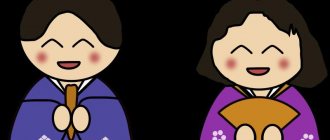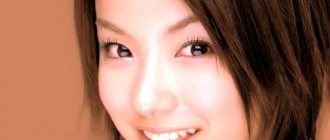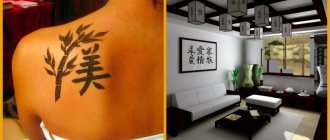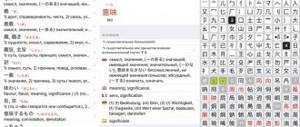At the beginning of studying, Japanese numbers raise many questions, since they have different pronunciations, Japanese proper, which is pronounced according to the kun reading of the hieroglyph, and Chinese, pronounced according to the on reading of the hieroglyph. Learning numbers is not difficult, the main thing is to remember in which case the kun or on reading is used.
Also, some numbers have two pronunciations - all that remains is to learn and remember in which combination this or that sound of the hieroglyph is pronounced.
Below are tables of abstract counting without application to days, years, number of items, etc. It's like we do when we just count to ten: one, two, three, four, five and so on. In this case, the Chinese pronunciation (on) is used.
Numerals in Japanese
Abstract counting numbers from zero to ten
| Number | Hieroglyph | Hiragana (on sound) | Pronunciation (romaji) | Meaning |
| 0 | 零 | ゼロ、れい | zero, rei | zero |
| 1 | 一 | いち | ichi | one |
| 2 | 二 | に | ni | two |
| 3 | 三 | さん | san | three |
| 4 | 四 | し、よん | shi、yon | four |
| 5 | 五 | ご | go | five |
| 6 | 六 | ろく | roku | six |
| 7 | 七 | しち、なな | shichi、nana | seven |
| 8 | 八 | はち | hachi | eight |
| 9 | 九 | く、きゅう | ku、kyu: | nine |
| 10 | 十 | じゅう | ju: | ten |
A children's video will help you, you will not only remember the pronunciation of numbers from 0 to 10, but also hear how the Japanese do it, since in some numbers (including in subsequent digits) the sound is reduced or lengthened. It's always useful to hear the pronunciation of a native speaker.
Thousands in Japanese
When forming thousands, the principle described in tens and hundreds is preserved. First, a number is used to show how many thousands, then the character sen (千) is added. When composing the numbers 4,000 and 9,000, you cannot use the unlucky sound; in the numbers 3,000 and 8,000 there is a slight change in sound due to the phonetic norms of the language.
List of thousands:
- 1,000 – sen (千);
- 2,000 – nisen (二千);
- 3,000 – sanzen (三千);
- 4,000 – ensen (四千);
- 5,000 – gosen (五千);
- 6,000 – rokusen (六千);
- 7,000 – nanasen (七千);
- 8,000 – hassen (八千);
- 9,000 – kyuusen (九百);
- 10,000 – man (万).
5,000 yen banknote
Numbers from 10 in Japanese
Japanese numbers after 10 are easy to remember; just learn the first ten. Each subsequent number is the result of adding 10 and the desired digit. So 11 is 10+1, in Japanese it looks like this:十i一 / じゅう + いち / ju:ichi
| Number | Hieroglyph | Hiragana (on sound) | Pronunciation (romaji) | Meaning |
| 11 | 十一 | じゅういち | ju: ichi | eleven |
| 12 | 十二 | じゅうに | ju:ni | twelve |
| 13 | 十三 | じゅうさん | ju: san | thirteen |
| 14 | 十四 | じゅうし じゅうよん | ju: shi ju: yon | fourteen |
| 15 | 十五 | じゅうご | ju: go | fifteen |
| 16 | 十六 | じゅうろく | ju: roku | sixteen |
| 17 | 十七 | じゅうしち じゅうなな | ju: shichi ju: nana | seventeen |
| 18 | 十八 | じゅうはち | ju:hachi | eighteen |
| 19 | 十九 | じゅうきゅう じゅうく | ju:kyu:ju:ku | nineteen |
| 20 | 二十 | にじゅう | ni ju: | twenty |
Counting tens in Japanese
As you noticed above, tens in Japanese are obtained as follows: first we call the desired number and add 10 to it. Visually it looks like this - 2 * 10 = 20 /二and十 / に and じ ゅう
| Number | Hieroglyph | Hiragana (on sound) | Pronunciation (romaji) | Meaning |
| 10 | 十 | じゅう | ju: | ten |
| 20 | 二十 | にじゅう | niju: | twenty |
| 30 | 三十 | さんじゅう | sanju: | thirty |
| 40 | 四十 | しじゅう よんじゅう | shiju: yonju: | fourty |
| 50 | 五十 | ごじゅう | goju: | fifty |
| 60 | 六十 | ろくじゅう | rokuju: | sixty |
| 70 | 七十 | しちじゅう ななじゅう | shichiju: nanaju: | seventy |
| 80 | 八十 | はちじゅう | hachiju: | eighty |
| 90 | 九十 | きゅうじゅう | kyu:ju: | ninety |
| 100 | 百 | ひゃく | hyaku | one hundred |
Remember:
- 九十 / きゅうじゅう / kyu: ju: / ninety
In this combination there is only one pronunciation; you cannot use the second meaning of the number 9 (ku)
What will the number 38 look like? Correct: 3*10+8,三十八/さんじゅうはち/sanju: hachi,
In this video you can get acquainted with Japanese numbers from the smallest to the very largest. It may be difficult to understand everything the first time, but once you master Japanese counting, in my opinion, this video is very informative.
If you want to know which counting suffix you need to use when talking about animals, books or other objects, then read the article counting suffixes in Japanese.
Account from 10,000
For Americans and Europeans, Japanese counting from 10,000 is difficult to understand due to the different system. In the Land of the Rising Sun, a division into classes is accepted: tens of thousands - mana, hundreds of millions - oku. Each class includes 4 categories.
Commonly used numbers with traditional Japanese notation divided into blocks of four:
- 1 0000 – man (まん);
- 10,0000 – juman (じゅうまん);
- 100,0000 – hyakuman (ひゃくまん) (million);
- 1000 0000 – senman (せんまん);
- 1 0000 0000 – oku (おく) (one hundred million);
- 10 0000 0000 – juuoku (じゅうおく) (billion);
- 100 0000 0000 – hyakuoku (ひゃくおく);
- 1 0000 0000 0000 – chou (ちょう) (trillion).
1,0000 yen banknote
Numbers in Japanese from 100
We learned above that 100 in Japanese is read as百/ひゃく/ hyaku. The hundreds place is formed by combining百with the digit we need. So the number 500 is the product of 5 and 100, that is, we take the number 5五/ご/ go and add百/ひゃく / hyaku =五百 /ごひゃく / gohyaku.
At the same time, in the category of hundreds, as well as in the category of thousands, new rules for stunning, voicing and doubling sounds appear; this must be remembered!
- 300 would sound like さんびゃく / san b yaku
- 400 only as よんひゃく / yon hyaku
- 600 – ろっぴゃく / ropp yaku
- 700 – ななひゃく / nana hyaku
- 800 – はっぴゃく / happ yaku
If you need to say one hundred, then there is also a change in pronunciation:一百 / いっぴゃく / ippyaku
| Number | Hieroglyph | Hiragana (on sound) | Pronunciation (romaji) | Meaning |
| 100 | 百 | ひゃく | hyaku | one hundred |
| 200 | 二百 | にひゃく | nihyaku | two hundred |
| 300 | 三百 | さんびゃく | sanbyaku | three hundred |
| 400 | 四百 | よんひゃく | yonhyaku | four hundred |
| 500 | 五百 | ごひゃく | gohyaku | five hundred |
| 600 | 六百 | ろっぴゃく | roppyaku | six hundred |
| 700 | 七百 | ななひゃく | nanahyaku | seven hundred |
| 800 | 八百 | はっぴゃく | happyaku | eight hundred |
| 900 | 九百 | きゅうひゃく | kyu:hyaku | nine hundred |
| 1000 | 千 | せん | sen | thousand |
The number 777 in Japanese will look like this: 七百七十七 / ななひゃくななじゅうなな /nanahyaku nanaju: nana
Number 357 - 三百五十七 / さんびゃくごじゅうなな / sanbyaku goju: nana
Numbers from 100 in Japanese
One hundred in Japanese is hyaku. If it is necessary to write down several hundreds, the required number is added to the symbol responsible for the hyaku: 500 consists of 5 and 100, 700 - from 7 and 100.
Sound and spelling:
- 100 – hyaku (百);
- 100 (one hundred) – ippyaku (一百);
- 200 – nihyaku (二百);
- 300 – sanbyaku (三百);
- 400 – enhyaku (四百);
- 500 – gohyaku (五百);
- 600 – roppyaku (六百);
- 700 – nanahyaku (七百);
- 800 – happyaku (八百);
- 900 – kyuuhyaku (九百);
- 1,000 – sen (千).
The attentive reader noticed that the pronunciation of individual numbers has changed. In 400 and 900 the Japanese use only the happy sound; in 100, 300, 600, 800 in hyaku the first consonant is transformed under the influence of the phonetic norms of the language.
Hyaku
Counting in Japanese - thousands
The principle of compiling numbers is the same as before, a thousand is added to the number, you just need to remember some features.
- 3000 – さんぜん / san dz en
- 4000 - よんせん / yon sen
- 7000 - ななせん / nana sen
- 8000 — はっせん/ hass en
| Number | Hieroglyph | Hiragana (on sound) | Pronunciation (romaji) | Meaning |
| 1000 | 千 | せん | sen | thousand |
| 2000 | 二千 | にせん | nisen | two thousand |
| 3000 | 三千 | さんぜん | sandzen | three thousand |
| 4000 | 四千 | よんせん | yonsen | four thousand |
| 5000 | 五千 | ごせん | gosen | five thousand |
| 6000 | 六千 | ろくせん | rokusen | six thousand |
| 7000 | 七千 | ななせん | nanasen | seven thousand |
| 8000 | 八千 | はっせん | hassen | eight thousand |
| 9000 | 九百 | きゅうせん | kyu:sen | nine thousand |
| 10000 | 万 | まん | man | ten thousand |
The number 1094 in Japanese will look like this: 千九十四 / せんきゅうじゅうよん / sen kyu: ju: yon
Number 6890 - 六千八百九十 / ろくせんはっぴゃくきゅうじゅう / rokusenhappyakukyu:ju:
Agree that the Japanese language is not so difficult that you refuse to study it, but it is very interesting and melodic that you decide to take a step towards understanding it. You will begin to think differently, learning any foreign language broadens your horizons, and the Japanese language is special in this regard, familiarity with grammar will help you better understand the mentality of the Japanese, different styles of speech will tell you about the versatility of relationships in Japanese society. Certified teacher, simultaneous interpreter Anna Reva and the online Japanese language school “Ikigai” will help you take an interesting path in learning the Japanese language.
Japanese account
Japanese counting is quite simple, although some Japanese numerals may sound different when pronounced. This happens for several reasons:
- the tone changes depending on the counting speed;
- some numbers have double reading. This is due to the fact that the sound of the number 4 (si or shi) coincides with the hieroglyph “death”. Therefore, 4 is often pronounced as “yon”, and 7 (siti) as “nana”.
Also in the Japanese language there are two categories of numerals - Chinese and Japanese. Chinese are used everywhere, while Japanese are used much less often and only to determine the numbers 1-10 and 20.
- Chinese numerals are used in martial arts training.
Chinese numerals:
| ray | zero |
| ichi | one |
| neither | two |
| san | three |
| si, yon | four |
| th | five |
| Roku | six |
| city, nana | seven |
| hati | eight |
| kyu | nine |
| ju | ten |
Further counting is done by adding units of count to tens:
| ju-ichi | eleven |
| ju-ni | twelve |
| ju-san | thirteen |
| ju-si, ju-yon | fourteen |
| jugo | fifteen |
| Ju-Roku | sixteen |
| ju-city, ju-nana | seventeen |
| ju-hachi | eighteen |
| ju-kyu | nineteen |
| no-ju | twenty |
Next, the required number is added to ten:
| ni-ju-ichi | twenty one |
| san-ju | thirty |
| si-ju, yon-ju | fourty |
| go-ju | fifty |
| Roku-ju | sixty |
| city-ju, nana-ju | seventy |
| Hachi-ju | eighty |
| kyu-ju | ninety |
| kyu-ju-kyu | ninety nine |
To name any number, you need to remember just three more words:
| hyaku | one hundred |
| Sep | thousand |
| man | ten thousand |
Thus:
| hyaku-ichi | 101 |
| ni-hyaku-ichi | 201 |
| go-hyaku-yon-ju-roku | 546 |
| san-sen-yon-hyaku-ni-ju-city | 3427 |
| go-man-san-sen-yon-hyaku-ni-ju-roku | 53426 |
The classes of Japanese numerals consist not of three, as in Russian, but of four digits.
Therefore, a million in Japanese is “ hyaku-man ” (one hundred per ten thousand).
To denote higher classes of numerals, the words " oku " (one hundred million) and " cho " (trillion) are used.
Exceptions:
- " si " to represent the number 4 is only used in the case of minor four. Those. You can use both " si " and " yon " in 1254, but only " yon " in 40, 400, 4000, etc.
- " city " for the number 7 is only used in the case of the minor seven. Those. You can use both " city " and " nana " in 9607, but only " nana " in 70, 700, 7000, etc. - 600 is roppyaku (but not roku hyaku ); - 800 is happyaku (but not hachi hyaku ); - 8000 is hassin (but not hati sin ).
Japanese numerals:
| hitotsu | one |
| futatsu | two |
| Mitsu | three |
| yotsu | four |
| itsutsu | five |
| mutsu | six |
| nanatsu | seven |
| yatsu | eight |
| kokonotsu | nine |
| That | ten |
| hatachi | twenty |
Japanese numerals
Next, let's look at the list of Japanese numerals. There are only ten of them and they are preserved from the old Japanese language. Previously, one in Japanese sounded like “hi”, two - “fu”, three - “mi” and so on. Japanese numerals are used in certain cases, such as:
- when you need to say the number of the month from one to ten. For example, April 2 will be 4月二日/しがつ ふつか/ shi gatsu futsuka
- when you need to say the number of days (from 1 to 10) expressing a period of time. For example: 3 days -三日/みっか/ mikka
- when indicating the number of small items (cake, bag, chair, etc.)
- when ordering
- when indicating age (unless a counting suffix indicating age さい is used), etc.
You can use the following hint: if the wordいくつ/ ikutsu / how much? is used in an interrogative sentence, then the answer must use numerals of Japanese origin. If the question consists of the Chinese (on) version of the reading 何 / なん、なに / nan, nani / question word - what?, how many, then the numbers given in the tables above are used.
Japanese numbers from 1 to 10
Counting and writing up to 10 in Japanese is as follows:
- One is ichi (一). When pronounced quickly, the last vowel is dropped, the word sounds like “ich”.
- Two – no (二).
- Three – san (三). Although it sounds like a mountain, the hieroglyphs are different.
- Four – en (alternative reading – shi) (四).
- Five - go (五).
- Six is roku (六). For a non-Japanese person, pronouncing this word correctly is not easy, since the first sound is something between r and l. When pronouncing, you need to use only the tip of your tongue.
- Seven – nana, rarely shichi (七).
- Eight – hachi (八). When speaking, you need to pause briefly between syllables.
- Nine – ku (九). A common mistake made by Japanese learners is turning the vowel into yu. This is incorrect: there should be a distinct y at the end.
- Ten – ju (十). The first letter is simultaneously similar to dz, zh and j.
When counting objects, not only numerals are used, but also suffixes indicating what exactly is being counted. If you cannot find a suitable suffix, you can use a simplified count:
- One is hitotsu (一つ). The first character corresponds to ichi from the sequence above, the second is taken from hiragana.
- Two – futatsu (二つ). The education system is similar to that described above.
- Three – mitsu (三つ). When pronounced, there is a slight pause between syllables, and the sound “ts” is somewhat lengthened, as if it were a letter and a half. If you write the word in alphabet, it will look like this: みっつ. The small symbol in the center means doubling the next sound.
- Four – yotsu (四つ). There is a short pause between syllables.
- Five – itsutsu (五つ).
- Six is mutsu (六つ). After the first syllable there is a short pause.
- Seven – nanatsu (七つ). When speaking, you need to pause before the last syllable.
- Eight – yatsu (八つ).
- Nine – kokonotsu (九つ). There are two pauses in speech: after “koko” and the next syllable.
- Ten - that (十). Of the ten, this word is the only one without the final hiragana character つ.
The system is based on kun reading, that is, traditional Japanese numbers.
To form an ordinal number, it is enough to add the sign 目 (me) to each of the kun numbers. Hitotsume is the first, futatsume is the second.
Counting in Japanese









